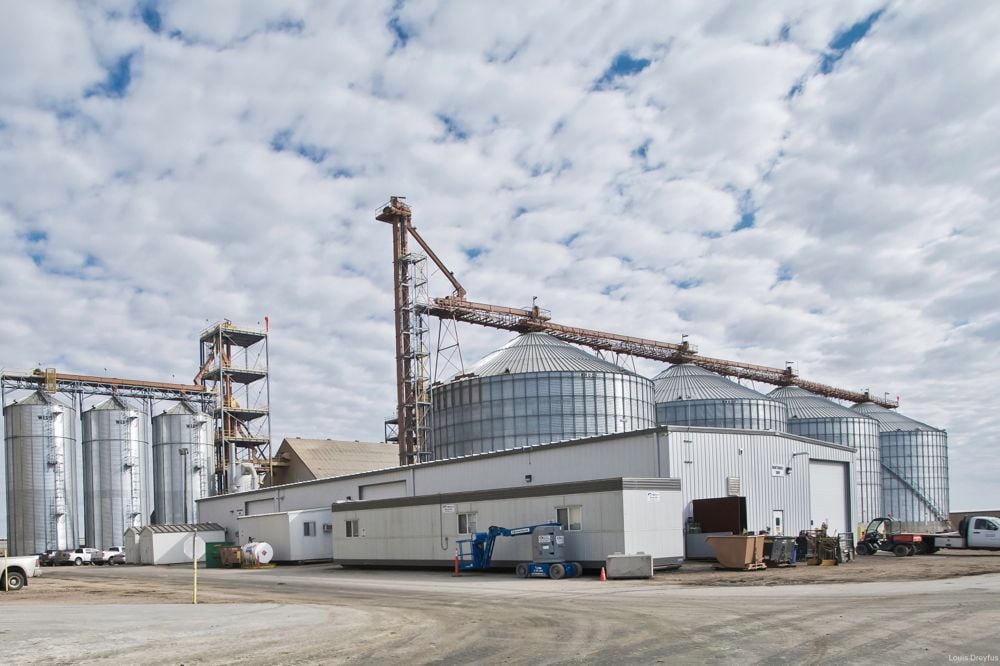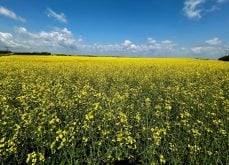Alberta
Peace
Pre-harvest spraying of peas has begun across many areas of the region including fields from Grimshaw to Dawson Creek, B.C. While crop conditions are generally dry, crops are still considered above average for many areas. Pockets of dry areas have advanced crops dramatically.
Harvest of peas and wheat at La Crete because of drought have begun, but with disappointing yields of 10 to 15 bushels per acre. Farmers are hoping later crops, including canola, yield better.
Fescue harvest is well underway with moderate yields because of dry crop conditions. Winter wheat crops are looking good and are expected to yield well. Lygus bug populations have increased and have farmers monitoring their fields for threshold levels.
Read Also

Louis Dreyfus posts higher volumes, lower profits in first half
Agricultural commodity merchant Louis Dreyfus Company recorded a rise in first-half sales, supported by higher volumes shipped, but weaker prices for most crops pushed down profits, it said on Friday.
North
Soil moisture conditions are generally good with periodic showers that also brought hail that wiped out a strip near Vermilion and Tofield.
Sclerotinia has started to show up, especially in heavy canola crops. High humidity has made disease a concern and is causing problems for haying in the area. Generally crops are looking good.
Some desiccation of peas is underway, but with a wide variation within the crops.
Cereal crops are beginning to turn. Expected hot weather will move maturation along quickly, but crops would do well with a few more showers to boost grain yields.
Barley silage is well underway with average yields.
Central
Hail has taken its toll on crops throughout the region. Hail claims in Alberta have grown by more than a thousand to well over 2,500. Numerous storms throughout the region saw heavy damage, especially in the Olds region where a wide swath wiped out entire crops.
Crops missed by the hail are looking extremely good. Cereal and oilseed crops are all rated as good to excellent, with many fields beginning to ripen. Hot weather is expected to hasten ripening and allow harvest to begin before the end of August.
Disease, especially in canola, has farmers checking their crops often. Aster yellows has appeared in canola crops and have robbed about five percent of yields.
South
The pulse harvest is well underway with good yields of peas, lentils and chickpeas. The early seeded barley harvest has also begun with yields in the mid 40-bushel per acre range.
Alberta Agriculture estimates more than 90 percent of the crops in the region are rated good to excellent, but with some signs of disease, especially in canola crops. Hot weather is expected to move crops along quickly. Farmers are having some difficulty putting hay crops up in good condition. A combination of showers and high humidity has given farmers only a small window to allow the crops to cure and dry.
Manitoba
Southwest
The winter wheat harvest is nearly complete. Yields are reported as average and quality is high. Dry conditions on a number a cereal crops have led to premature ripening on the saline parts of fields.
Cereal crops have turned and producers are either desiccating fields or have begun swathing.
Pastures are reported as average to below average. Producers that began grazing in May are beginning to worry about pasture deterioration.
Central
Scattered showers hit the region last week, which should aid soybean and corn crops. Producers continue to swath canola. Aster yellows is present at higher than normal levels. Blackleg is also being found in canola.
Spring wheat harvest is ongoing with yields reported from 50 to 60 bushels per acre.
Edible bean yields look promising. Producers are reporting good pod development.
Northwest
Hot weather in late July helped dry fields in the Swan River region. Some fields still have standing water and yellow crops.
Economic levels of lygus bugs are present in many canola fields. Lygus bugs and alfalfa plant bug have restricted pod set in forage seed crops around Dauphin.
Perennial grass seed crops are being swathed.
Most of the hay crop has been baled or silaged in the southern half of the region. Wet conditions have delayed the harvest in the northern half.
Eastern
A hot, dry July stalled pasture regrowth and dried up dugouts. Drought conditions are most severe in the southeast, where producers are pumping water or deepening dugouts for livestock.
The majority of canola has reached maturity and swathing is underway.
Flax has progressed from boil filling to maturity. Aster yellows is present in many flax fields but impact on yield is uncertain.
Interlake
Bacterial blight and septoria brown spot is evident in some soybean fields but the diseases shouldn’t restrict yield.
Root rot is affecting some spring wheat fields. Infection levels are near five percent in some wheat crops.
Swathing of canola and barley crops is underway.
Pasture conditions rated as good, with the exception of a few with excess moisture.
Saskatchewan
South
Livestock producers have over 90 percent of the hay crop cut and over 85 percent baled or put up as silage. Ninety-six to ninety-seven percent of the hay crop is rated good to excellent.
Rainfall in the region has ranged from 167 millimetres in the Radville area to 481 mm in Tantallon since April 1.
Topsoil moisture conditions are rated 82 percent surplus or adequate in the southeast and 51 percent in the southwest.
Harvest has begun on winter cereals, pulses and mustard crops. Crops are showing signs of heat stress and yields are expected to be below normal in some areas.
Tornadoes, strong winds, heavy rains and root rot have caused lodging in many crops.
Central
Over 80 percent of the hay crop has been cut and 72 percent baled or put up as silage. More than three-quarters of the hay crop is in good to excellent condition.
Since April 1, rainfall has ranged from 231 mm in the Quill Lake area to 488 mm in the Sonningdale region.
Topsoil moisture conditions are rated 92 percent surplus or adequate in east-central and 98 percent in west-central Saskatchewan.
Harvest will begin soon on earlier-seeded pulses and winter cereals.
Most canola crops have high levels of aster yellows and producers are now scouting for bertha armyworms. Some fields have sustained significant disease damage from sclerotinia, rust and leaf spot diseases.
Strong winds and heavy rains have caused lodging and flooding and a storm caused significant damage to some areas of west-central Saskatchewan.
North
More than three-quarters of hay crops have been cut and over 60 percent baled or put into silage. Eighty to 100 percent of the hay crop is rated good to excellent.
Rainfall has ranged from 183 mm in the Dorintosh area to 455 mm near Kinistino.
Cropland topsoil moisture is rated 92 to 100 percent surplus or adequate.
Harvest will not begin for several weeks.
Producers are spraying for leaf diseases, sclerotinia and for aphids in canaryseed and flax fields. Bertha armyworms are approaching the economic threshold level in some areas and aster yellow damage is becoming a concern.














